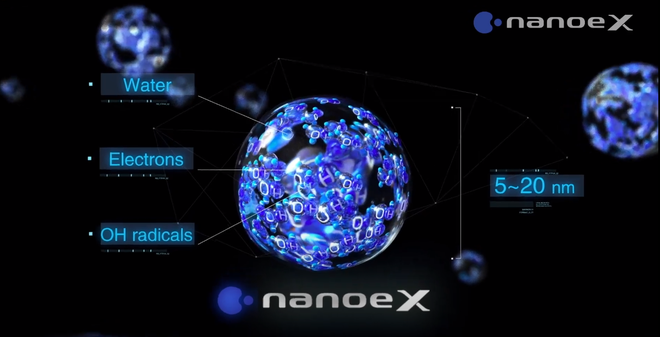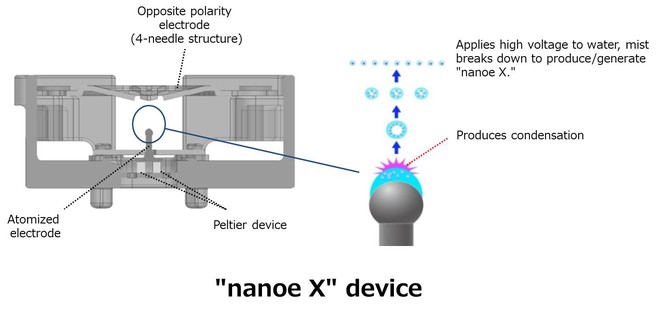Texcell uses a set of viral infection criteria to draw conclusions about this rate of inhibition.
Recently, Panasonic Vietnam Company said: In a study in cooperation with Texcell Global Contact Research Organization, Texcell verified the effectiveness of SARS-CoV-2 virus inhibition of Nanoe ™ X technology Japanese electronics company integrates in many of its appliances, from refrigerators, hairdryers to air purifiers and air conditioners.
Recently, Panasonic Vietnam Company said: In a study in cooperation with Texcell Global Contact Research Organization, Texcell verified the effectiveness of SARS-CoV-2 virus inhibition of Nanoe ™ X technology The Japanese electronics company s ‘integrates many of its appliances, from refrigerators, hairdryers to air purifiers and air conditioners. Product X) is a technology that uses electrodes to discharge high voltage in water vapor, to create water particles 5 to 20 nm in size containing OH radicals. These OH radicals are very oxidizing and can attack and inactivate viruses when exposed to them.
In test results published by Panasonic, a Nanoe ™ X transmitter in a sealed 45 liter box was shown to be 99.99% inhibitor of the SARS-CoV-2 virus after 2 hours. job.

SARS-CoV-2 is the official name of the corona virus responsible for the COVID-19 pandemic around the world. “Texcell Global Contact Research Organization tests have confirmed that the reception of nanoe ™ X technology has an inhibitory effect on this virus,” said the press release from Panasonic.
However, the company also pointed out, “This verification is carried out with the aim of creating basic research data on the effects of nanoe ™ X on the novel corona virus under different laboratory conditions. normal living space. Not used to evaluate product performance. “.
Nanoe ™ X technology
Nanoe ™ X is the latest Nanoe technology developed by Panasonic since 1997, aiming to create water nanoparticles containing an OH base. OH radicals are an inherent component of the natural atmosphere, produced in the atmosphere by the reaction between sunlight and water and terpenes (compounds secreted by plants) or between terpenes and oxzone.
Thanks to their strong oxidizing power, OH radicals present in the atmosphere can eliminate certain greenhouse gases such as methane or ozone, inactivate viruses, pathogenic bacteria, neutralize floral cells and spores responsible for molds . and allergies. For this reason, OH radicals are also called “detergents” of the troposphere.
However, atmospheric OH radicals are not effective in indoor air. Natural OH radicals also have a very short lifespan, only lasting less than a second. With the idea of bringing OH radicals into indoor air and prolonging their lifecycle, Panasonic has developed the Nanoe product line which produces OH-based water particles to take advantage of their superior capabilities. .
Panasonic introduces Nanoe X technology
The Nanoe ™ X is a high voltage discharge device made up of four opposing electrodes (X-shaped). It collects water vapor from indoor air, then releases it through these vapor droplets, creating an electrolytic and ionizing reaction. The water particles will be split to the size of 5-20nm, containing billions of OH radicals.
In an interview with NTX, Mr. Takehiko Ryu, Regional Director for Southeast Asia and Oceania and CEO of Panasonic Asia, said the Nanoe ™ X device can generate more than $ 4.8 trillion. Roots out OH per second and increases their lifespan by 10 minutes.
With its high concentration and long life in air, Nanoe ™ X is believed to be able to purify the air as well as clean interior surfaces. “(Water particles) nanoe ™ X can even penetrate fabrics like curtains, blinds, rugs, as well as hard surfaces like our furniture to block harmful substances and keep us out. and your loved ones safe and sound, ”said Mr. Takehiko Ryu.
Inhibits 99.99% of SARS-CoV-2 virus for 2 hours
In 2012, Panasonic declared that it had verified the inhibitory effect of Nanoe ™ X against agents such as fungi, bacteria and viruses. Their latest study in 2020 was conducted with Texcell to confirm whether OH-based nanoparticles were inhibiting the SARS-CoV-2 virus that caused the COVID-19 pandemic.
Texcell is a global research organization specializing in virus testing, virus elimination, vaccination, research and development, or the GMP cell bank, for R&D projects. With over 30 years of experience and based at the Institut Pasteur in Paris, Texcell is recognized for its expertise in virus detection with a wide range of potential agent detection procedures.

Nanoe ™ X testing with SARS-CoV-2 was performed in a closed laboratory environment. The Panasonic device is placed at a height of 15 cm in the test space with a capacity of only 45 liters. A pre-injected swab of SARS-CoV-2 virus solution was placed in a Petri dish to come into contact with OH-based nanoparticles emitted by Nanoe ™ X at various intervals.
Panasonic’s press release said that after 2 hours, 99.99% of the SARS-CoV-2 virus in the gauze was inhibited. Texcell uses a set of viral infection criteria to draw conclusions about this rate of inhibition.
Carried out in a standard test environment, Panasonic says the test is “not designed to assess effectiveness in uncontrolled living spaces.” Therefore, it makes sense to confirm that Nanoe ™ X can inhibit the SARS-CoV-2 virus, and not to assess the performance of products currently incorporating this technology on the market.
“Panasonic will continue to harness the potential of nanoe ™ X technology to tackle air pollution issues such as new pathogens for a healthy, safe and comfortable living environment. for people around the world, ”the company said.


